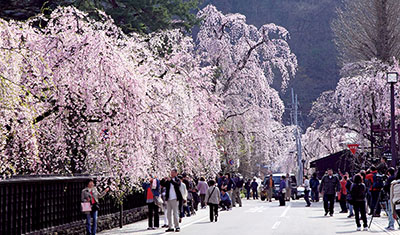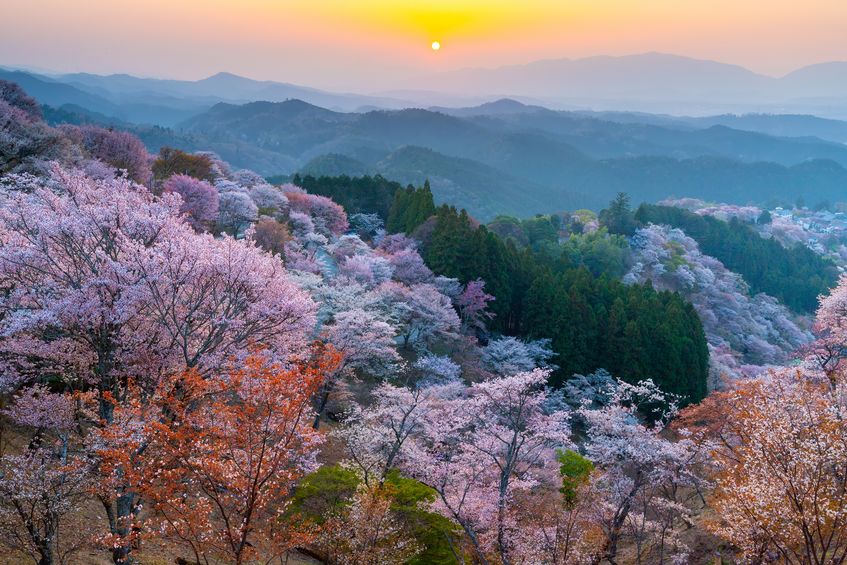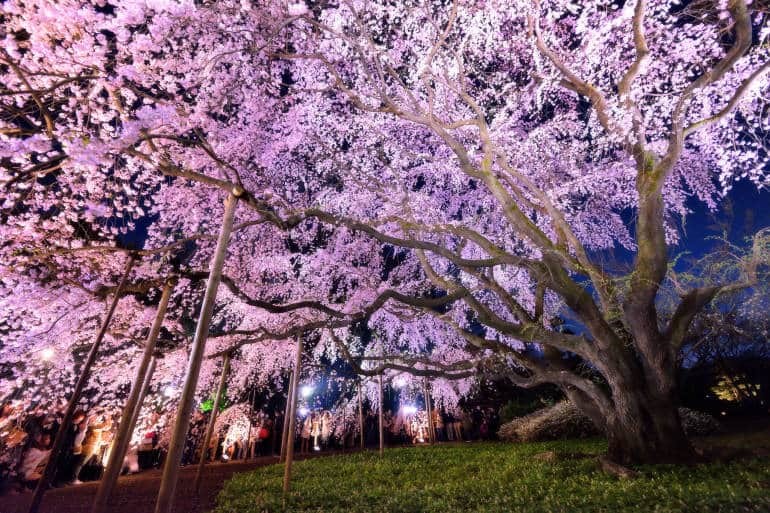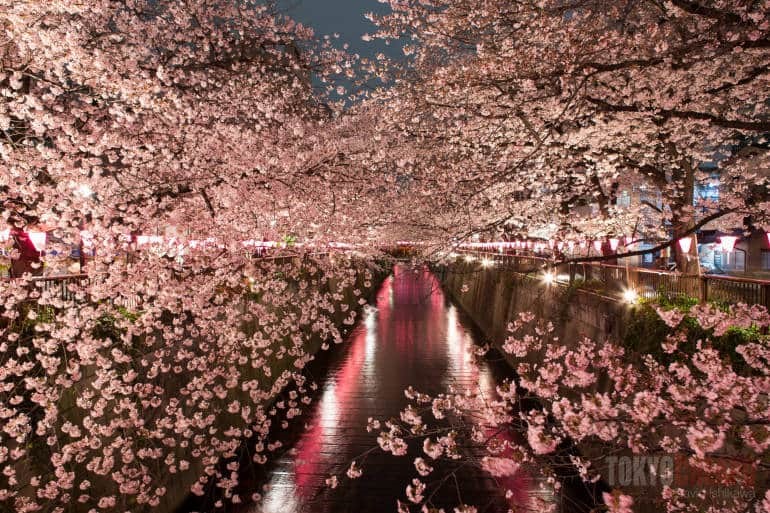Japan is an amazing country where tradition meets the future.
A place where unbelievable skylines are mixed with stunning nature. Travel to Japan in April and you’ll experience spring under the cherry blossoms.
From the end of March to early May, cherry trees bloom all over Japan, painting Japan pink.
Hanami, or cherry blossom festival, is one of Japan’s most ancient festivals, but it’s celebrated as enthusiastically today as ever.

 Hanami, literally meaning ‘flower viewing’, is a long-standing, much anticipated Japanese tradition of welcoming spring.
Hanami, literally meaning ‘flower viewing’, is a long-standing, much anticipated Japanese tradition of welcoming spring.
For some, hanami is just a stroll in the park, but most people organise a picnic with friends, families or colleagues. In parks, on riverbanks, and anywhere else where cherry blossoms are to be found, you’ll see groups of people sitting around eating and drinking.
Stuff you need to know about the cherry blossom festival in Japan
How to hanami like a local
First, pick up some food, ideally a delicious seasonal bento box, from a local supermarket or ground-floor food hall of a department store.
Next, buy some drinks, disposable cups and – a vital component – a blue tarpaulin to sit on in the park. Then, simply find an empty space beneath the trees and enjoy.
- Hanami parties: These parties under the sakura in parks involve blue tarps, snacks and beverages.
- Sakura festivals: These provide food stalls, pretty lanterns and sometimes entertainment.
- Yozakura: This refers to cherry blossoms that are illuminated at night.
- Hikes: Your best chance of seeing some quiet blossoms in their natural habitat is to head out into the mountains for a spring walk. Pack a picnic and you’ve got yourself the perfect day out.
- River cruises: Cherry blossom season makes for scenic boat rides. One of the advantages of being on a boat during hanami season is that you can see the view without standing in a crowd. Wasen rides in a traditional Japanese boat take place during weekends of the cherry blossom festival. Night cruises are available, or you can charter a
yakatabune , a traditional Japanese boat for individuals or small groups.
What to bring
A camera, possibly a selfie stick if you wish to blend into the crowds, comfortable shoes, warm clothes, a jacket and two pairs of socks. Spring in Japan can still be pretty cold in the evenings.
What to remember
Cherry blossom season is one of the busiest times of year to travel. It’s worth bearing this in mind if you’re heading to popular spots such as Kyoto.
Visit Japan and see the wonderful cherry blossom blooming whilst taking in some amazing places along the way.
To help you plan the perfect hanami, we have put together a list of must-see spots throughout

Goryokaku Fort - Hokkaido
 Goryokaku
Goryokaku
Over 1,000 cherry trees were planted along its moats, creating one of Hokkaido’s best hanami spots. Blooming usually starts in early May, and the adjacent Goryokaku Tower offers an incredible bird’s-eye view of the fortress.
Hirosaki Castle Park
 On the northern tip of Japan’s main island of Honshu is Aomori Prefecture, home of Hirosaki Castle. Three-story Hirosaki, built in 1611, homes more than 2,600 cherry trees in and around its walls and gardens.
On the northern tip of Japan’s main island of Honshu is Aomori Prefecture, home of Hirosaki Castle. Three-story Hirosaki, built in 1611, homes more than 2,600 cherry trees in and around its walls and gardens.
Part of what sets the view here apart from other viewing destinations are cherry blossom tunnels, as well as the petal-filled moats.
Best viewing: April 23-May 5
Kakunodate - Akita
 Known as a samurai district, Kakunodate is characterized by broad streets and lots of open courtyards.
Known as a samurai district, Kakunodate is characterized by broad streets and lots of open courtyards.
These are shaded by large weeping cherry blossom trees said to have been planted by samurai themselves and imported from Kyoto in the Edo Period (1603–1868).
Best viewing: April 23–May 6
Hanamiyama Park - Fukushima
 Outside a small village in Fukushima Prefecture, Hanamiyama is a hillside park and hanami hot spot.
Outside a small village in Fukushima Prefecture, Hanamiyama is a hillside park and hanami hot spot.
The cherry trees were originally planted by local farmers. Because it’s located in the northern region of Tohoku, the trees don’t bloom until mid-April.
While the park is somewhat remote, that seclusion offers a lovely mountain view juxtaposed with the blossoms.
And a shuttle bus from Fukushima Station makes getting there a breeze.
Ueno Park - Tokyo
Shinjuku Gyoen - Tokyo
 A little more peaceful, there are around 1,300 cherry trees, which bloom at different stages in Shinjuku Gyoen Park. At 144-acres, it is spacious with nice big lawns and plenty of walking paths, you can still enjoy a chilled stroll under the sakura, even when it’s crowded. The atmosphere here is much less rowdy compared to Ueno Park. Thanks to the early and late blooming trees, Shinjuku Gyoen is a good hanami destination for those who miss the main season by a week or two.
A little more peaceful, there are around 1,300 cherry trees, which bloom at different stages in Shinjuku Gyoen Park. At 144-acres, it is spacious with nice big lawns and plenty of walking paths, you can still enjoy a chilled stroll under the sakura, even when it’s crowded. The atmosphere here is much less rowdy compared to Ueno Park. Thanks to the early and late blooming trees, Shinjuku Gyoen is a good hanami destination for those who miss the main season by a week or two.
Best viewing: March 22–April 7
Nakameguro - Tokyo
 Nakameguro is Tokyo’s best neighbourhood for seeing cherry blossoms, largely thanks to its canal-like waterway. Each spring, the more than 800 trees that line it
Nakameguro is Tokyo’s best neighbourhood for seeing cherry blossoms, largely thanks to its canal-like waterway. Each spring, the more than 800 trees that line it
Mount Fuji / Lake Kawaguchi - Shizuoka
 The Five Lakes region is not only a prime spot to view Mount Fuji but also a great place to catch the sakura.
The Five Lakes region is not only a prime spot to view Mount Fuji but also a great place to catch the sakura.
Lake Kawaguchi is surrounded by cherry blossom trails that continue onward to Nagasaki Park.
For centuries, artists have used the view of Mount Fuji framed with cherry blossoms as inspiration for their paintings, prints and artwork.
Blossoms from late April to early May.
Kawazu - Shizuoka
The 8,000 trees in Kawazu, on the east coast of the Izu Peninsula, are some of the earliest blooming in Japan, with pink and white petals appearing in early February and lasting for about a month. Bundle up and enjoy the 4-kilometre walk along the Kawazu River that’s flanked by cherry trees. The Kawazu Cherry Blossom Festival attracts almost two million visitors annually as one of the earliest opportunities in the year to see large numbers of cherry blossoms near Tokyo.
Best viewing: Early February to early March
Maruyama Park - Kyoto
The famed ancient capital of Japan provides a perfectly dreamy backdrop for cherry blossom appreciation – albeit alongside the biggest crowds of the year. Maruyama Park is Kyoto’s oldest park, and one of the ancient capital’s most popular spots for cherry blossom viewing: it’s packed with hanami picnickers from day to night. And while it’s pleasant enough to stroll under the park’s cherry trees during daylight hours, most visit at night to see Maruyama’s famed
Best viewing: March 30–April 7
Philosopher's Path - Kyoto
 Also known as Tetsugaku no Michi, the stone Philosopher’s Path is a 2-kilometre-long (1.24-mi) path lined with hundreds of cherry trees that follows the canal in Kyoto’s Higashiyama district.
Also known as Tetsugaku no Michi, the stone Philosopher’s Path is a 2-kilometre-long (1.24-mi) path lined with hundreds of cherry trees that follows the canal in Kyoto’s Higashiyama district.
Named after Nishida Kitaro, a famous Japanese philosopher believed to walk the route daily on his way to Kyoto University, the path winds between cherry trees that hang over the path and canal.
Best viewing: March 30–April 7
Kema Sakuranomiya Park - Osaka
Kema Sakuranomiya Koen, in Osaka, covers approximately 4 kilometres between Tenma Bridge and the Okawa Bridge. There are over 4,000 trees along the riverside, which typically bloom in early April. While the park is free to enter and there are plenty of spots along the river perfect for a picnic, there are also water buses that travel up and down the river, providing a perfect, effortless view of the whole park.
Mount Yoshino
 In the Nara Prefecture, Mount Yoshino has long been one of Japan’s most famous spots for viewing cherry blossoms, in part because its range of elevation means not all of its 30,000 cherry trees bloom at the same time.
In the Nara Prefecture, Mount Yoshino has long been one of Japan’s most famous spots for viewing cherry blossoms, in part because its range of elevation means not all of its 30,000 cherry trees bloom at the same time.
The first trees here were supposedly planted some 1,300 years ago.
Best viewing: April 5–14
Himeji Castle
 Just four hours west of Tokyo by train, Himeji Castle, considered to be one of the most beautiful places in the country, only reopened to the public in 2015 after years of renovations. Combine the historical and cultural significance with the cherry blossoms bloom on the castle grounds in early April, and you’ve got a dream destination. The castle – said to resemble a heron in flight – has cherry blossom trees in both its free and paid areas.
Just four hours west of Tokyo by train, Himeji Castle, considered to be one of the most beautiful places in the country, only reopened to the public in 2015 after years of renovations. Combine the historical and cultural significance with the cherry blossoms bloom on the castle grounds in early April, and you’ve got a dream destination. The castle – said to resemble a heron in flight – has cherry blossom trees in both its free and paid areas.
Best viewing: March 26–April 5


